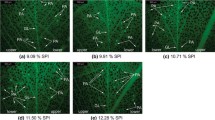Abstract
The desire to make more biobased and lower-cost bonded wood products has led to an interest in replacing some phenol and formaldehyde in wood adhesives with soybean flour. Improved knowledge of the soy protein properties is needed to relate resin chemistry to resin performance before and after wood bonding. To expose the soy protein’s functional groups, it needs to be disrupted, with minimal hydrolysis, to maximize its incorporation into the final polymerized adhesive lattice. The best conditions for alkali soy protein disruption were to maintain the temperature below 100 °C and react the soy flour with sodium hydroxide at pH 9–12 for about 1 hour. A gel permeation chromatography procedure was optimized to determine conditions for selectively breaking down the high molecular weight soy protein fragments that contribute to high adhesive viscosity. This method and extraction data were used to evaluate the reaction of the disrupted soy flour protein with formaldehyde and phenol to provide a stable adhesive. The results were used to develop more economical adhesives that are ideally suited for the face section of oriented strandboard.






Similar content being viewed by others
References
Kreibich RE, Steynberg PJ, Hemingway RW (1997) End Jointing Green Limber With SoyBond, in Proceedings, Wood Residues into Revenue, Residual Wood Conference, November 4–5, Richmond, BC
Hse CY, Fu F, Bryant BS (2001) Development of Formaldehyde-Based Wood Adhesives With Co-Reacted Phenol/Soybean Flour, in Proceedings, Wood Adhesives 2000, South Lake Tahoe, NV. Forest Products Society, Madison, WI
Kuo M, Myers D, Heemstram H, Curry D, Adams DO, Stokke DD (2001) Soybean-Based Adhesive Resins and Composite Products Utilizing Such Adhesives, U.S. Patent 6,306,997 B1
Li K, Peshkova S, Geng X (2004) Investigation of Soy Protein–Kymene Adhesive Systems for Wood Composites. J Am Oil Chemists Soc 81(5):487–491
Wescott JM, Frihart CR, Traska AE (2006) High Soy Containing Water Durable Adhesives. J Adhesion Sci Technol 20(8):859–873
Vijayendran BR, Clay J (2001) Some Recent Studies on Soy Protein-Based Wood Adhesives, in Proceedings, Wood Adhesives 2000, South Lake Tahoe, NV. Forest Products Society, Madison, WI
Kinsella JE (1979) Functional Properties of Soy Proteins. J Am Oil Chemists Soc 56:242–258
Anderson T, Carlsson M, Hagel L, Pernemalm PA (1985) Agarose-Based Media for High-Resolution Gel Filtration of Biopolymers. J Chromatography 326:33–44
Conner AH, Lorenz LF, Hirth KC (2002) Accelerated Cure of Phenol-Formaldehyde Resins: Studies With Model Compounds. J Appl Polymer Sci 86:3256–3263
Walker JF (1975) Formaldehyde. 3rd edn., Krieger Publishing Co., Huntington, New York
Frihart CR, Wescott JM (2004) Improved Water Resistance of Bio-Based Adhesives for Wood Bonding, in Proceedings, 1st International Conference on Environmentally Compatible Forest Products, September 22–24, Porto, Portugal, pp 293–302
Wescott JM, Frihart CR (2004) Competitive Soybean Flour/Phenol–Formaldehyde Adhesives for Oriented Strandboard, in Proceedings, 38th International Wood Composites Symposium, April 6–8, Pullman, Washington
ASTM International, Standard Test Methods for Evaluating Properties of Wood-Base Fiber and Particle Panel Materials, D 1037–99, Vol. 04.10, Annual Book of ASTM Standards, American Society of Testing and Materials International, West Conshohocken, PA (2005)
Author information
Authors and Affiliations
Corresponding author
About this article
Cite this article
Lorenz, L., Frihart, C.R. & Wescott, J.M. Chromatographic Analysis of the Reaction of Soy Flour with Formaldehyde and Phenol for Wood Adhesives. J Amer Oil Chem Soc 84, 769–776 (2007). https://doi.org/10.1007/s11746-007-1097-6
Received:
Revised:
Accepted:
Published:
Issue Date:
DOI: https://doi.org/10.1007/s11746-007-1097-6




